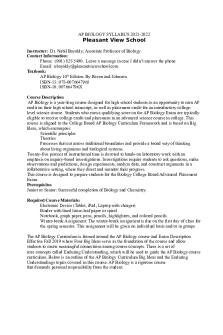Microevolution vs Macroevolution biology worksheet 2021 PDF

| Title | Microevolution vs Macroevolution biology worksheet 2021 |
|---|---|
| Course | Bioinformatics |
| Institution | Ferris State University |
| Pages | 3 |
| File Size | 122.2 KB |
| File Type | |
| Total Downloads | 82 |
| Total Views | 124 |
Summary
worksheet/ notes summary cop version 2-3...
Description
Theory of Evolution by Natural Selection
Analyse how an accumulation of micro-evolutionary changes can drive
evolutionary changes and speciation over time, for example:
Evolution of the horse
Evolution of the platypus What is Microevolution? Microevolution refers to the small changes that occur within a species due to mutations in genes resulting in new alleles. Over a long time, many microevolutionary changes will result in a macro-evolutionary change which is an evolution on a larger scale which is what we are better at noticing. Click on the following link and complete the activities that follow. https://artofsmart.com.au/hsctogether/microevolutionary-changes/ 1. Watch the video on Defining Microevolution and Macroevolution. Questio
Question
Answer
n no 1
Describe the
evolution is the change in the characteristics of a species over several generations and relies on the process of natural selection.
concept of evolution 2
What is speciation?
the evolutionary process by which populations evolve to become distinct species
3
Define evolution
the process by which different kinds of living organism are believed to have developed from earlier forms during the history of the earth
4
2 Types of
Convergent and divergent
evolution 5
What is microevolution? Give one example
6
(beetles) Describe the
evolutionary change within a species or small group of organisms, especially over a short period one example : antibiotic resistance 1. Gene flow:
factors that affect allele frequency in a 7
gene pool. What is a species?
8
9
2. Natural selection 3. Mutation 4. Genetic drift These factors force evolution and contribute to it a group of living organisms consisting of similar individuals capable of exchanging genes or interbreeding.
Define macroevolution
studying patterns on the tree of life above the species level, and inferring the processes that are likely to have generated these patterns
If a new species
true
evolves the new species can successfully reproduce with their ancestors? True or False? 10
Summary of events that lead to macroevolution
Often microevolution can lead to macroevolution as changes become more pronounced and two distinct species emerge. Both are caused by mutation, genetic drift, gene flow or natural selection
5. Watch video on Evolution of the Horse and make dot point notes.
Concept of evolution: 1. Different bacterial individuals were exposed to different selection pressures
2. This led to the development of new species 3. The new species developed into new species
Type of evolution: 1. Micro evolution – the small-scale variation of allele frequencies in the gene pool of a species 2. Macro evolution – The variation in allele frequencies at or above species level
6. Watch video on Evolution of the Platypus and make dot point notes. -
One of the last mammals who lay eggs
-
Many other monotremes have been extinct
-
People believe platypus survived living in Australia as it was invaded by marsupials by having a bill
-
Their bill allows them to hunt for food in an interesting way
-
The flat surface of the bill means the electroreceptors are spread out which makes the platypus accurately work out the direction of the electro signal...
Similar Free PDFs

Macroevolution - Lecture notes 1
- 10 Pages

Worksheet 2 - Biology
- 2 Pages

Microevolution - Lecture notes 3
- 6 Pages

Biology 150 2021
- 6 Pages

AP Biology Syllabus 2021
- 5 Pages

1.1 Terminology Worksheet 2021
- 3 Pages

James Worksheet 2021
- 4 Pages

2021 Penrith Biology Trial Paper
- 50 Pages
Popular Institutions
- Tinajero National High School - Annex
- Politeknik Caltex Riau
- Yokohama City University
- SGT University
- University of Al-Qadisiyah
- Divine Word College of Vigan
- Techniek College Rotterdam
- Universidade de Santiago
- Universiti Teknologi MARA Cawangan Johor Kampus Pasir Gudang
- Poltekkes Kemenkes Yogyakarta
- Baguio City National High School
- Colegio san marcos
- preparatoria uno
- Centro de Bachillerato Tecnológico Industrial y de Servicios No. 107
- Dalian Maritime University
- Quang Trung Secondary School
- Colegio Tecnológico en Informática
- Corporación Regional de Educación Superior
- Grupo CEDVA
- Dar Al Uloom University
- Centro de Estudios Preuniversitarios de la Universidad Nacional de Ingeniería
- 上智大学
- Aakash International School, Nuna Majara
- San Felipe Neri Catholic School
- Kang Chiao International School - New Taipei City
- Misamis Occidental National High School
- Institución Educativa Escuela Normal Juan Ladrilleros
- Kolehiyo ng Pantukan
- Batanes State College
- Instituto Continental
- Sekolah Menengah Kejuruan Kesehatan Kaltara (Tarakan)
- Colegio de La Inmaculada Concepcion - Cebu







